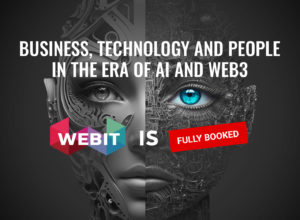Posts by WEBIT_Admin
How Many Jobs Will AI Eliminate? C-Suite Executives Make Their Bets
Adapted from Forbes Research, October 14, 2025 Forbes
In a sweeping new Forbes Research 2025 AI Survey, more than 1,000 C-suite executives across sectors were asked to weigh in on a pressing question: Will artificial intelligence destroy jobs — or create new ones? The findings show a generally cautious optimism among top leaders about AI’s impact on the workforce.
A Moderated View on Job Loss
A dominant takeaway is that most executives don’t foresee mass job eliminations in the near term. In fact, 94 % of respondents believe that fewer than 5 % of current roles will disappear over the next two years due to AI integration. Forbes This outlook challenges the more alarmist view that AI is set to displace swathes of employees imminently. Rather, for many of these executives, the transition will be incremental and manageable.Growing Confidence in AI’s Constructive Role
Beyond limiting job losses, a striking proportion of executives—59 %—say they expect AI to generate net new job opportunities, not just eliminate roles. Forbes This is a clear shift from the prior year: in 2024, only a third of executives held this more positive view. The jump suggests greater confidence in AI as a transformative, rather than purely disruptive, force.Addressing Employee Concerns: From Fear to Partnership
One of the biggest hurdles to AI adoption is employee anxiety—especially fears about job security. Many executives named “fear of job loss” as a top barrier to successful AI rollout. Forbes To counter that, 68 % of organisations are actively reframing their internal narrative around AI. Instead of positioning AI as a replacement, they emphasize a collaborative future of human + machine. Forbes As one executive put it, “helping employees trust and adapt to new tools without fearing replacement” is essential for meaningful adoption. Forbes The sentiment is echoed in public statements from tech and retail leaders, who often stress that AI should augment human capabilities, not displace them.Workforce Realignment and Internal Mobility
Executives aren’t just talking—some are already reshuffling roles. Survey results show that 44 % of CHROs (Chief Human Resources Officers) have reassigned employees from non-AI roles into domains that overlap with AI or data work. Forbes Simultaneously, many organizations are scaling training, mentorship, and career development programs to help existing staff transition and grow in the AI-augmented environment. Forbes The goal is clear: rather than shedding people, these companies aim to reskill and redeploy talent.Uneven Adoption Across Business Functions
Where AI is applied varies substantially. 69 % of executives report using AI in IT infrastructure, technical operations, and core systems. Forbes But further down the org chart, adoption is much sparser:- Only 3 % say AI is used in HR operations
- Just 2 % note AI use in legal functions
Key Takeaways & Forward View
From the survey, a few overarching themes emerge:- Measured optimism over alarmism The prevailing view is one of cautious balance: AI is transformative, not apocalyptic.
- Narrative matters Over two-thirds of companies are actively recasting AI as a tool for human augmentation, not replacement.
- Talent is being redeployed, not eliminated Talent strategies emphasize reskilling over layoffs.
- Adoption is uneven but expanding AI’s early strongholds are in technical functions, but organizations aim to broaden use cases.
- Transition is evolutionary, not revolutionary The timeline is gradual; few expect immediate, sweeping job cuts.
10 Generative AI Trends in 2026 That Will Transform Work and...
(Adapted from Bernard Marr’s article in Forbes, October 2025)
In 2026, generative AI will no longer feel experimental — it’s becoming a fundamental part of how organizations operate and how individuals create, learn, and communicate. What began with tools like ChatGPT in 2023 has now evolved into a multi-industry revolution, reshaping workflows, creativity, and innovation.
While challenges like copyright disputes, bias, job transformation, and ethical oversight continue, the potential of generative AI — to accelerate productivity, spark creativity, and extend human capability — is undeniable. According to Forbes contributor Bernard Marr, here are ten key trends set to define 2026:
1. Generative Video Comes of Age
AI-generated video production is becoming a serious creative tool. Shows like Netflix’s El Eternauta already use AI to enhance animation and reduce costs. By 2026, expect large studios and creators alike to rely more heavily on generative tools for visual effects, storytelling, and editing.2. Human Authenticity Becomes a Differentiator
As AI floods the internet with auto-generated content, audiences will crave authenticity. Real voices, emotional storytelling, and unique cultural perspectives will stand out. The human touch — what feels “genuinely lived” — will become a key competitive advantage.3. Copyright Clashes Intensify
The debate over who owns the data that trains AI will heat up. As generative models rely on massive datasets of human-created work, legal disputes and regulatory efforts will grow. 2026 will likely see new frameworks emerge to protect creators while allowing innovation to continue.4. From Chatbots to AI Agents
AI assistants will move beyond responding to prompts. They’ll act autonomously — planning, prioritizing, and completing tasks across apps and systems. Platforms like ChatGPT’s Agent Mode, Gemini, and Claude are early examples of this transition toward proactive digital partners.5. Privacy-Focused AI Solutions
Concerns about data security are leading to demand for on-device or private-cloud AI. Businesses and individuals will increasingly seek systems that ensure control over sensitive information while maintaining high generative performance.6. Gaming Revolutionised by AI
Games will become more immersive through AI-driven storytelling, dynamic environments, and lifelike characters. Developers will use generative AI to cut costs and expand creativity — while players experience worlds that feel truly adaptive and intelligent.7. Synthetic Data for Safer AI Training
Generative AI will increasingly produce synthetic data for use in simulations and analytics. This allows organisations — especially in healthcare, finance, and research — to train models effectively without compromising real personal data.8. Generative Search Redefines the Web
AI is transforming search. Tools like Google’s Search Generative Experience and platforms such as Perplexity are blending conversational summaries with ad models. In 2026, new monetization structures will arise as search becomes more interactive and contextual.9. Scientific Discovery Accelerated by AI
Generative AI is becoming a core tool in science — speeding breakthroughs in fields like drug design, climate research, and materials engineering. AI can now generate hypotheses, simulate results, and guide researchers toward faster discoveries.10. New AI Roles and Careers Emerge
AI isn’t just replacing jobs — it’s creating new ones. Roles like prompt engineers, AI ethicists, model trainers, and AI auditors are becoming essential. In 2026, these professions will form the backbone of how organizations collaborate with intelligent systems.The Bigger Picture
As Forbes highlights, the boundary between human and machine creativity is fading fast. Generative AI will continue reshaping industries — from entertainment to science — while demanding new skills, ethical guidelines, and a rethinking of how we define originality and value. Organizations that embrace these changes with curiosity and responsibility will be the ones to thrive in the age of intelligent creation.🚀 Founders Games 2025 Applications Are Open!
Are you a visionary founder driving innovation, impact, and growth?
This is your moment to take the global stage.
If you’re:
✅ In or planning an investment round
✅ Creating measurable social & environmental impact
✅ Looking for exposure to international investors, corporates, and media
Then Founders Games is where you belong. 🌍
💡 Why Apply?
💰 FUNDING OPPORTUNITIES – For the past 15 years, winners have closed $5M–$50M rounds within months.
🎯 350+ LEADING VCs SCREEN YOU – From Sequoia, Khosla Ventures, Lakestar, DN Capital, Earlybird, and icons like Tim Draper.
🌎 GLOBAL VISIBILITY – Past winners featured in TIME Magazine, Fast Company, and other major outlets.
🎤 STAGE IN DAVOS – The Grand Finale during the World Economic Forum in front of 200+ investors.
🏆 UP TO $6M IN FUNDING AWARDS – One of the world’s biggest startup prizes.
📢 POWERFUL NETWORKS – Join Webit’s 1.5M+ global ecosystem of investors, policymakers, and innovators.
🔥 Your moment is now!
🔗 Apply here:
https://www.webit.org/en/startup_challenge_application.html/791?foundersgames
📌 Questions?
Check the FAQ or reach out — we’re happy to help!
#FoundersGames #Webit #ImpactInnovation #ScaleUp #Entrepreneurship #VCFunding #Davos #Founders
We are at FULL CAPACITY for Webit 2025 – Web3 &...
📍 Where: National Palace of Culture (NDK), Sofia
📅 When: June 26
🕗 Registration starts tomorrow at 8:00 AM (EET)
🌍 Join top global leaders in business, tech, policy, media, and startups as we dive into how AI and Web3 are transforming industries — from healthcare and finance to green innovation and beyond.
💡 Expect bold ideas, breakthrough innovations, and the people shaping the future.
⚠️ We’re fully booked and beyond excited! If you’ve secured your spot — be there early!
Let’s make history at #Webit2025. We’re expecting you. 🙌
We’re thrilled to welcome Bozhidar Doychinov, First Investment Bank, to the...
Bozhidar is a driving force behind Fibank’s digital innovation—blending cutting-edge technology with real-world usability to redefine the customer experience. He has led the transformation of the My Fibank mobile app into a go-to banking platform, introducing instant transfers, peer-to-peer payments, and even enabling users to trade stocks and ETFs directly from their phones. 📊💡
With a career dedicated to pushing the boundaries of digital banking, Bozhidar brings sharp insight into how financial institutions can thrive in a tech-driven world, while always keeping the user front and centre.
Get ready to be inspired by a leader helping shape the future of finance, one digital breakthrough at a time. 🌐💼
All participants were carefully selected and personally invited leaders from industries they represent, and now fewer than 20 public tickets for public sale are available before we close registration.
👉 Book Tickets now:
https://www.webit.org/2025/sofia/tickets.php
#Webit #Webit2025 #Innovation #Webitchangemakers
We’re thrilled to welcome Angelina Borisova to the #Webit2025 Main Stage!
As Founder of Anagami Digital Accounting and Autsorsa | HR & BPO Solutions, Angelina is building smarter, scalable businesses through strategic accounting and global talent solutions. 🚀
At Anagami, she leads a team delivering cross-border tax, finance, and compliance, now expanding into Dubai and the UAE to support globally minded companies.
With Autsorsa, she helps organisations tap into top talent across Europe, the UK, and the Middle East—making remote hiring fast, compliant, and effective. 🌐💼
All participants were carefully selected and personally invited leaders from industries they represent, and now fewer than 20 public tickets for public sale are available before we close registration.
👉 Book Tickets now:
https://www.webit.org/2025/sofia/tickets.php
#Webit #Webit2025 #Innovation #Webitchangemakers
We’re excited to announce Spas Ivanov, BaseLine CyberSecurity, as a featured...
With nearly two decades of experience guarding digital frontiers, Spas is a trusted name in both national and international security projects.
He leads Bulgaria’s first fully operational Security Operations Centre (SOC) — a major milestone for the country’s cyber defence landscape 🔒🌐
As a certified ISO 27001 lead auditor and advisor to countless organisations, Spas brings hands-on expertise in helping businesses stay ahead of evolving threats and compliance standards. His leadership is shaping how the public and private sectors approach cyber resilience.
All participants were carefully selected and personally invited leaders from industries they represent, and now fewer than 20 public tickets for public sale are available before we close registration.
👉 Book Tickets now: https://www.webit.org/2025/sofia/tickets.php
#Webit #Webit2025 #Innovation #Webitchangemakers
We’re thrilled to welcome Serkan Girgin, Google to #Webit2025!
With two decades of experience across #B2C and #B2B marketing, Serkan Girgin brings a sharp perspective on how tech transforms business.
Before joining Google in 2012, Serkan held senior roles at global powerhouses like Pepsi, Danone, and Lipton. Now, he leads Google’s marketing efforts in Türkiye and has previously overseen Ads Marketing across the EMEA region.
Now, Serkan is exploring the next frontier: how #AI-powered platforms like #Gemini transform from simple tools into true teammates for marketers and creatives.
🎟 This is an exclusive, invitation-only event, with only 50 public tickets available.
If you want to be part of shaping the future, this is your moment.
https://www.webit.org/2025/sofia/tickets.php
We’re delighted to welcome Alex Garmash, tbi bank, to Webit 2025...
With over two decades of experience spanning global consulting firms, C-suite roles, and cross-industry transformations, Alex is a true strategist at the intersection of finance, innovation, and operational excellence.
At tbi bank, he’s spearheading growth and partnerships across Bulgaria, Romania, and Greece — helping to reshape the region’s merchant and fintech landscape.
From McKinsey and Alvarez & Marsal to the frontlines of banking innovation, Alex brings a rare blend of insight and execution.
His academic credentials — from London Business School to Harvard, Wharton, and Oxford — reflect a lifelong commitment to mastering complex global systems and driving impact where it matters most.
🎟 This is an exclusive, invitation-only event, with only 50 public tickets available. If you want to be part of shaping the future, this is your moment.
https://www.webit.org/2025/sofia/tickets.php
#Webit2025 #FintechLeadership #DigitalBanking #TBIbank #TransformationExpert #BusinessGrowth #WebitSpeakers #FutureOfFinance








